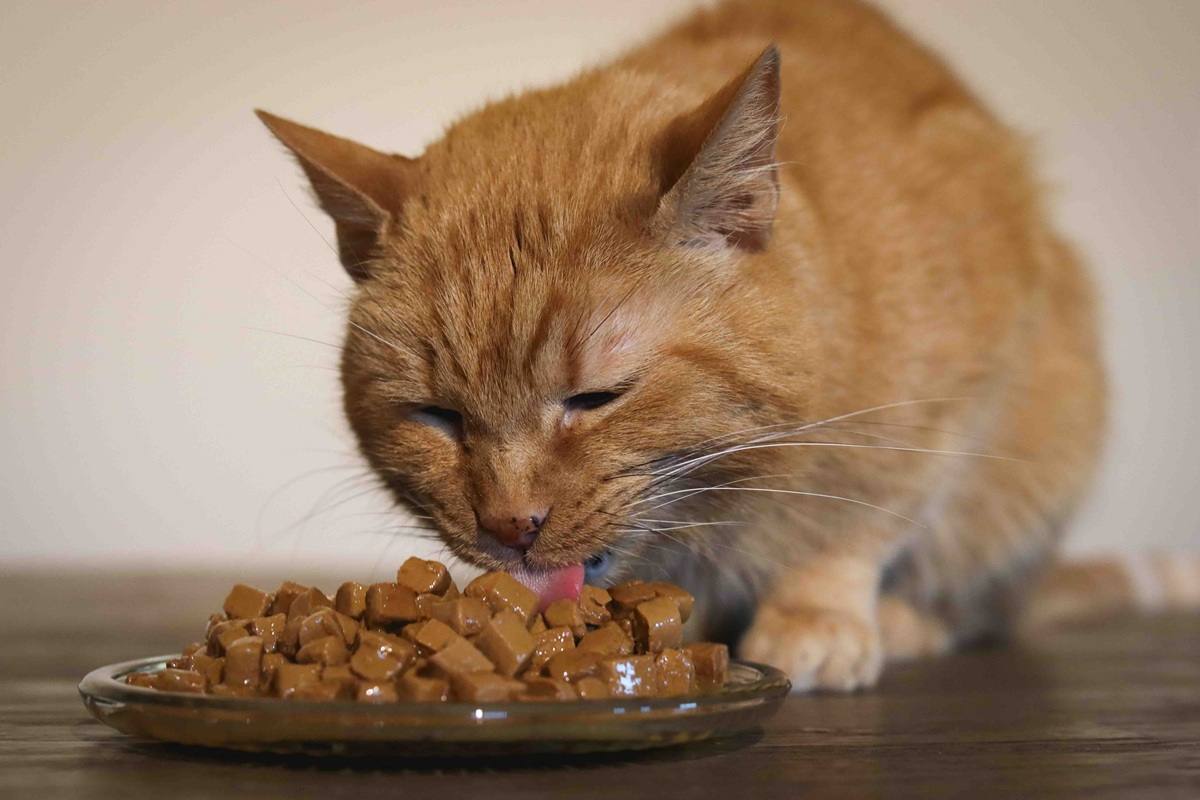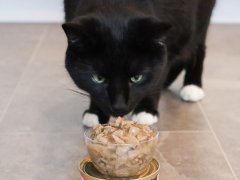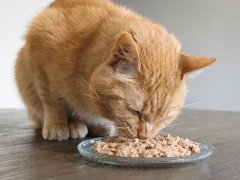
Kirsten McCarthy / Cats.com
Artificial colors, flavoring agents, and other synthetic food additives have the potential to harm your cat’s health. However, it’s important to differentiate between fact and fiction when making decisions about cat food based on ingredients.
Carrageenan often appears in lists of cat food ingredients to avoid. But is it really that bad? I was surprised to learn that much of what pet owners think about this additive seems to be based on outdated evidence. Let’s discuss carrageenan’s role in cat food, the controversy surrounding this ingredient, and some alternatives to carrageenan.
The Role of Carrageenan in Cat Food
Carrageenan is a common additive in food made for both pets and people. It thickens, stabilizes, and emulsifies mixtures. Basically, it improves the product’s stability and keeps individual ingredients from separating.
In human food, you’ll find carrageenan in ice cream, yogurt, and even soy milk. It’s also used as an emulsifier in personal care products like toothpaste, liquid soaps, and hair products. In pet food, carrageenan is typically used in high-moisture products like canned cat food.
Though it may sound like a chemical additive, carrageenan is derived from red seaweed. Carrageenan is the most commonly used term for this ingredient, but it may also appear on pet food labels as vegetable gum, vegetable gelatin, or red seaweed extract. Most cat foods contain carrageenan.[1]
Undegraded vs. Degraded Carrageenan

Carrageenan is found in many cat foods, both canned and dry kibble. Kirsten McCarthy / Cats.com
A quick Internet search for carrageenan yields some confusing results. Countless websites mention that carrageenan is linked to immune reactions, inflammation, and digestive issues. Some even call it a carcinogen. However, the U.S. Food and Drug Administration (FDA) and numerous regulatory bodies worldwide recognize carrageenan as a safe food additive. So, what’s the truth?
A closer look into those search results shows that much of what’s written about carrageenan in pet food has been debunked.[2] Early studies were conducted using a form of carrageenan that is not used in pet food. There are two types of carrageen: undegraded carrageenan (food-grade) and degraded carrageenan.
Carrageenan is a natural substance found in red seaweed. Its high molecular weight prevents it from being absorbed during digestion.[3]
When carrageenan is subjected to extreme heat and acid in a lab, it degrades into something with a completely different molecular structure—poligeenan. Poligeenan is a synthetic substance with a low molecular weight, so it can be absorbed in the intestines.[4]
Many of the early studies used poligeenan instead of food-grade carrageenan, but they are not interchangeable. Poligeenan does trigger gastrointestinal inflammation, immune reactions, and digestive issues like inflammatory bowel disease. Studies have not shown that food-grade carrageenan acts the same way.
Outdated Carrageenan Research
If you’re wondering how something like this could go unnoticed for so long, you’re not alone. I asked Dr. Jo Myers, DVM, a veterinarian at Vetster, to help me understand. Here’s how she explained it:
“Among other factors, the early studies confused the relevant terminology and didn’t design their experiments to reflect real-life situations, so the conclusion that carrageenan is dangerous was eventually debunked.”
A 2018 review published in Critical Reviews in Food Science and Nutrition supports this suggestion. “In part, this confusion was due to the nomenclature used in early studies on [carrageenan], where poligeenan was referred to as ‘degraded carrageenan’ (d-CGN) and ‘degraded carrageenan’ was simply referred to as carrageenan.” While the nomenclature has been updated, misinterpretation of that early data has led to the “subsequent dissemination of incorrect information regarding the safe dietary use of [carrageenan].”[5]
Despite new studies supporting the safety of carrageenan, a small population continues to spread unsupported claims about its dangers. Many of them cite research conducted by Joanne Tobacman. Tobacman’s research focused on the inflammatory effects of carrageenan. She suggested that even low-level inflammation linked to carrageenan consumption could, over time, contribute to serious diseases like heart disease, Alzheimer’s, and cancer.[6]
Other researchers have tried to replicate Tobacman’s results—and they’ve all failed. This calls into question the validity of Tobacman’s research. In 2008, the FDA even sent a letter directly to Tobacman refuting her claims against the safety of carrageenan. The FDA also denied Tobacman’s 2012 petition to prohibit the use of carrageenan in the United States.
So Is Carrageenan Safe for Cats?

Carrageenan is a common food ingredient and is generally accepted to be safe. Kirsten McCarthy / Cats.com
Yes, the general consensus among scientists is that pure carrageenan is a safe food additive. The FDA continues to include food-grade carrageenan in its list of “Generally Recognized as Safe” (GRAS) human food additives. The World Health Organization (WHO) and United Nations Food and Agriculture Organization (FAO) have also approved its use in animal food.
All this being said, more research is needed. Numerous studies have debunked the theory that carrageenan triggers negative health effects like inflammation and toxicity. But several scientific reviews have also noted a lack of definitive data on the long-term safety and effects of carrageenan.[7]
Dr. Neus Torrent, DVM, a veterinarian and animal nutritionist for Outdoor Bengal, says “The evidence regarding carrageenan’s safety remains inconclusive, with some studies indicating potential harm and others suggesting it is safe for consumption.”
The scientific community seems to be of the mind that, unless serious health effects are discovered in future studies, carrageenan should be considered safe. Dr. Myers puts it this way: “There is no scientific evidence backing up any safety concerns about carrageenan in cat foods, so there’s no need to avoid it.”
Carrageenan Alternatives
Texturizing ingredients like carrageenan are unlikely to impact your cat food’s overall makeup. But we don’t have conclusive data on the long-term effects of carrageenan consumption in cats. If you and your vet decide you should avoid it, look for a cat food brand that advertises carrageenan-free products.
Here are a few brands that offer carrageenan-free wet food formulas:
Pet food manufacturers that don’t use carrageenan may use alternative ingredients to thicken or emulsify their products. Some of the most common alternatives are plant-derived polysaccharide hydrocolloids like guar gum or sodium alginate.[8]
However, animal-derived alternatives like animal plasma or gelatin may be more species-appropriate for cats. “Gelatin serves similar purposes [to carrageenan] in terms of texture and stability, but it is 100% protein,” says Dr. Torrent, “So, it is more digestible and increases the nutritional value of the food.”
To wrap things up, Dr. Myers offers the following advice to cat owners: “If you’re unsure whether a nutrition-related question is fact or fiction, contacting a licensed veterinary professional is important.”
Frequently Asked Questions
What are the other names for carrageenan in cat food?
Carrageenan is derived from red algae or red seaweed, so it may be listed on a cat food label as red seaweed extract. Other terms that may be used include processed Eucheuma seaweed (PES), vegetable gelatin, Eucheuma spinosum gum, and marine colloids.
Is carrageenan okay for cats?
The type of carrageenan used in cat food is considered by the FDA and other international regulatory boards.
What are the side effects of carrageenan?
There are no known side effects of food-grade carrageenan in cats or humans. Outdated studies once suggested that carrageenan may cause inflammation in the digestive tract, but they have been debunked.
-
Food Additives Permitted for Direct Addition to Food for Human Consumption | Gums, Chewing Gum Bases and Related Substances SEC. 172.620 Carrageenan, Food and Drug Administration Department of Health and Human Services
-
Younes, M., Aggett, P., Aguilar, F., Crebelli, R., Filipič, M., Frutos, M. J., Galtier, P., Gott, D. M., Gundert‐Remy, U., Kuhnle, G. G., Lambré, C., Leblanc, J., Lillegaard, I. T. L., Moldéus, P., Mortensen, A., Oskarsson, A., Stanković, I., Waalkens‐Berendsen, I., Woutersen, R. A., . . . Dusemund, B. (2018). Re‐evaluation of carrageenan (E 407) and processed Eucheuma seaweed (E 407a) as food additives. EFSA Journal, 16(4).
-
Ha, H. T., Cường, Đ. X., Thuy, L. H., Thuan, P. T., Tuyen, D. T. T., Mơ, V. T., & Dong, D. H. (2022). Carrageenan of Red Algae Eucheuma gelatinae: Extraction, Antioxidant Activity, Rheology Characteristics, and Physicochemistry Characterization. Molecules, 27(4), 1268.
-
Ariffin, S. H. Z., Yeen, W. W., Abidin, I. Z. Z., Wahab, R. M. A., Ariffin, S. H. Z., & Senafi, S. (2014). Cytotoxicity effect of degraded and undegraded kappa and iota carrageenan in human intestine and liver cell lines. BMC Complementary and Alternative Medicine, 14(1).
-
McKim, J. M., Willoughby, J. A., Blakemore, W. R., & Weiner, M. L. (2018). Clarifying the confusion between poligeenan, degraded carrageenan, and carrageenan: A review of the chemistry, nomenclature, and in vivotoxicology by the oral route. Critical Reviews in Food Science and Nutrition, 59(19), 3054–3073.
-
Tobacman, J. K. (2001). Review of harmful gastrointestinal effects of carrageenan in animal experiments. Environmental Health Perspectives, 109(10), 983–994.
-
Borsani, B., De Santis, R., Perico, V., Penagini, F., Pendezza, E., Dilillo, D., Bosetti, A., Zuccotti, G. V., & D’Auria, E. (2021). The role of carrageenan in inflammatory bowel diseases and allergic reactions: Where do we stand? Nutrients, 13(10), 3402.
-
GlobalPETS. (2023, December 7). The role of emulsifiers and stabilizers in wet pet food - Go-to resource for the global pet industry | GlobalPETS. Go-to Resource for the Global Pet Industry | GlobalPETS.








The first time I heard about Carageenan being bad for cats was in your guys video by Malory Crusta. So, now you are saying it is not as bad as once thought. I appreciate the come back, but also seems that more research should have been done? I have read a scientific article stating that for carageenan to become carcenogenic, it will have to go through the invironment that is not suitable for life. In other words, no living creature has a temperatue of 80 degrees celcium in their stomach, for it to become carcenogenic. Thank you for this article though.
The second time I inadvertently gave our cat a wet food with carrageenan, the next day (today) she upchucked her breakfast, later regurgitated some Royal Canin sensitive digestion kibble. She also had a soft stool this morning. She had similar symptoms the first time I gave her food with this stuff in it. I WILL be more careful to make sure her wet food does not have carrageenan in it.
hey, so this is great info, the problem is that there are cat food reviews on this very website that are spreading the misinformation that this article warns about. the review for Special Kitty brand cat food makes specific mention of carrageenan as a dangerous ingredient, and deducts points from the product’s score because of it. thats actually how i found this article, because i immediately went and searched why it was considered bad. ive noticed an increasing amount of conflicting information like that in the cat food reviews on cats.com, and to be honest i find it very confusing what metrics yall use to determine if a food is good or not, as the criteria seems to change from review to review. whats good and fine for one brand is not so for another. this is a shame because i used to rely on this site for quality breakdowns of whats in the food before i feed it to my cats. i also love the youtube channel.
Hi Galaxy,
Thank you for your feedback, we try to stay consistent as possible while we do use many different writers. Our editorial team is going to have a deeper look at the Special Kitty brand cat food and review this.